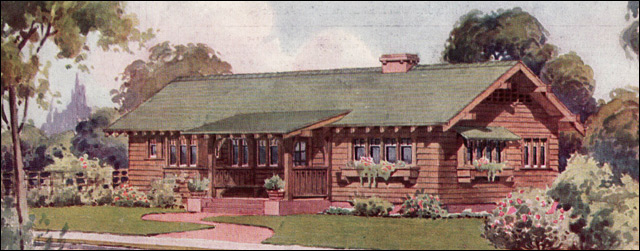Kit Home Plans
By Year
- 1908 Western Home Builder
- 1915 Hewitt-Lea-Funck
- 1915 Ready Built
- 1916 Lewis Mfg.
- 1922 Lewis Mfg.
- 1922 Stillwell
Bungalow House Plans
From Books and Kits — 1900 to 1930
 We
suppose there are people who might be able to ignore the many charms of
the bungalow image above, but honestly don't understand them. This house
is representative of the many plans we've accumulated and republished
here.
We
suppose there are people who might be able to ignore the many charms of
the bungalow image above, but honestly don't understand them. This house
is representative of the many plans we've accumulated and republished
here.
Many were designed to fit the needs and budgets of ordinary working people. With the expansion of industrialization, hundreds of thousands of Americans were on the move from the small, rural towns that dotted the countryside to the rapidly developing cities.
Suburban neighborhoods grew quickly from 1900 to the start of WWI, paused briefly to endure a war and its aftermath that included a post-war recession, before resuming even more rapid growth during the Roaring 20s. Strong populist and labor movements empowered the working classes and expanded worker rights. Concurrent trends in social sciences raised awareness of society and culture on health and well being. Hard sciences not only continued proving the causes of disease but provided planners with the means to prevent many including typhoid and cholera through improved water treatment and hygiene.
The bungalow was designed to be open and light, built of natural materials, by skilled craftsmen. They were literally the embodiment of all that was good and pure. Trendsetting designers like Gustav Stickley, Elbert Hubbard, and Frank Lloyd Wright we committed to bringing good, small homes to as many people as possible.
The ornate Victorians were discarded as tacky and in bad taste. From about 1900 to 1920, the bungalow was the home style of choice for the modern trendsetter. Many were designed in a rustic or artistic manner and used many of the craftsman-style characteristics popularized by Stickley in his publication The Craftsman.
A second competitor that fused traditional with modern bungalow style, was the transitional bungalow. These bungalows often had the broad front porch and open floor plan of a typical craftsman-style bungalow, but few of the decorative elements lacking the knee brackets and wide overhanging roof.
During the 1920s, every small home was called a bungalow. We tend to be purists about bungalow vs. romantic revival style and for our purposes here, will focus only on the more narrow definition of what a bungalow is. (For more information about home styles during the first few decades of the 20th century, refer to the the style definitions at Antique Home Style.)
Let us know what you think. Send us an email anytime.
© 2011 — Bungalow Home Style
